

How parents utilize reinforcement and punishment to impact the behaviour of their teenage children. How parents utilize reinforcement and punishment to impact the behavior of their teenage children. Teenager - Understanding the growing child. Teenager. Two teens, listening to music together A teenager, or teen, is someone who is between 13 and 19 years old.
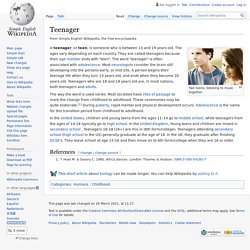
The ages vary depending on each country. They are called teenagers because their age number ends with "teen". The word "teenager" is often associated with adolescence. Most neurologists consider the brain still developing into the persons early, or mid-20s. The way the word is used varies. In the United States, children and young teens from the ages 11–14 go to middle school, while teenagers from the ages of 14-18 typically go to high school.
Nemours KidsHealth - the Web's most visited site about children's health. Tips for Parents with Teenagers - How to Survive the Teen Years! Operant conditioning. What Is Operant Conditioning? Definition and Examples. Operant conditioning occurs when an association is made between a particular behavior and a consequence for that behavior.
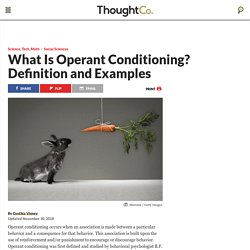
This association is built upon the use of reinforcement and/or punishment to encourage or discourage behavior. Operant conditioning was first defined and studied by behavioral psychologist B.F. Skinner, who conducted several well-known operant conditioning experiments with animal subjects. Key Takeaways: Operant Conditioning. Untitled. Positive reinforcement. Primary, secondary and social reinforcers example. Positive Reinforcement in Psychology (Definition + 5 Examples) If you read our earlier piece on positive punishment, you know that there are different methods of teaching and instilling good habits and behaviors.
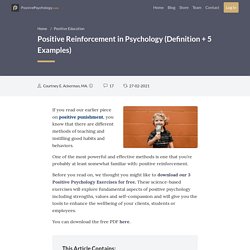
One of the most powerful and effective methods is one that you’re probably at least somewhat familiar with: positive reinforcement. Before you read on, we thought you might like to download our 3 Positive Psychology Exercises for free. These science-based exercises will explore fundamental aspects of positive psychology including strengths, values and self-compassion and will give you the tools to enhance the wellbeing of your clients, students or employees. Positive Reinforcement - Tips for teaching and parenting.
The value of reinforcing positive behaviour for our teens. As children approach adolescence, they sometimes begin testing limits, bending the rules and otherwise going against the grain.

While this is normal behaviour for teens, it can be incredibly trying for you, as a parent. Teenagers may also be dealing with the stresses that come with trying to fit in with their peers and assert their growing independence. However, at the same time, they are looking for validation from the adults around them. It's crucial, therefore, for parents and teachers to provide as much guidance and positive reinforcement as possible, rather than simply tightening the rules.
While it may be challenging to reward and praise a teen, who may appear to be indifferent to us, it's well worth the effort. Negative reinforcement. Negative reinforcement: Definition and examples. What Is 'negative Reinforcement'? Definition And Real-World Examples.
You've heard of negative reinforcement, but how do you put it into practice?
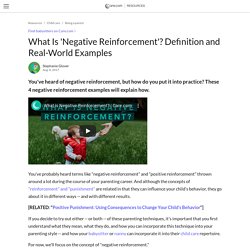
These 4 negative reinforcement examples will explain how. You've probably heard terms like "negative reinforcement" and "positive reinforcement" thrown around a lot during the course of your parenting career. And although the concepts of "reinforcement" and "punishment" are related in that they can influence your child's behavior, they go about it in different ways -- and with different results. [RELATED: "Positive Punishment: Using Consequences to Change Your Child's Behavior"] If you decide to try out either -- or both -- of these parenting techniques, it's important that you first understand what they mean, what they do, and how you can incorporate this technique into your parenting style -- and how your babysitter or nanny can incorporate it into their child care repertoire. For now, we'll focus on the concept of "negative reinforcement. " Résultats Google Recherche d'images correspondant à.
Images.

Positive punishment. Positive Punishment: What It Is, Benefits, and Examples. Positive punishment is a form of behavior modification.
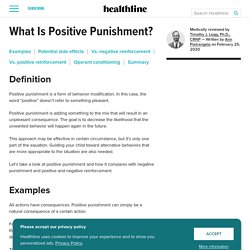
In this case, the word “positive” doesn’t refer to something pleasant. Positive punishment is adding something to the mix that will result in an unpleasant consequence. The goal is to decrease the likelihood that the unwanted behavior will happen again in the future. This approach may be effective in certain circumstance, but it’s only one part of the equation.
Guiding your child toward alternative behaviors that are more appropriate to the situation are also needed. Positive Punishment: What Is It And How It Works? - MomJunction. Positive punishment!

Sounds like a perfect oxymoron. But how can a punishment be positive? How can you even enforce such a punishment? Is it effective? Before many such questions crop in your mind, let us explain what we are going to tell you in this post. The Study of Punishment in Psychology. Punishment is a term used in operant conditioning to refer to any change that occurs after a behavior that reduces the likelihood that that behavior will occur again in the future.

Negative punishment. How Negative Punishment Works. Negative punishment is an important concept in B.
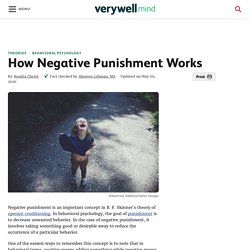
F. Skinner's theory of operant conditioning. In behavioral psychology, the goal of punishment is to decrease unwanted behavior. In the case of negative punishment, it involves taking something good or desirable away to reduce the occurrence of a particular behavior. One of the easiest ways to remember this concept is to note that in behavioral terms, positive means adding something while negative means taking something away. Negative Punishment Examples and Scenarios. Nobody ever wants their stuff taken away. Untitled. The Difference Between Positive and Negative Reinforcement - Danielle Forshee, Psy.D, LCSW. Behavioral issues can begin at a young age and carry on through a person’s entire life if not dealt with accordingly.
Reinforcement is what we use to help increase the probability that a behavior will occur with the use of a stimulus or item as soon as the required response or behavior is shown. If this doesn’t make sense, in simple terms; it is a reward for a certain behavior. Reinforcement procedures have been commonly used with children, teenagers, the elderly, animals, and for many psychological disorders. The reinforcement used can be either positive or negative, each having different outcomes completely. Reinforcement schedules. How Reinforcement Schedules Work. Operant conditioning is a learning process in which new behaviors are acquired and modified through their association with consequences. Reinforcing a behavior increases the likelihood it will occur again in the future while punishing a behavior decreases the likelihood that it will be repeated.
In operant conditioning, schedules of reinforcement are an important component of the learning process. When and how often we reinforce a behavior can have a dramatic impact on the strength and rate of the response. Schedule of Reinforcement A schedule of reinforcement is basically a rule stating which instances of behavior will be reinforced. Reinforcement schedules take place in both naturally occurring learning situations as well as more structured training situations. Some schedules are better suited to certain types of training situations.
Schedules of reinforcement and punishment — TECKS. Prepared by John Church, PhD, School of Educational Studies and Human Development University of Canterbury, Christchurch, New Zealand. Which method is effective? Discipline for Teens: Strategies and Challenges. When your child becomes a teenager, your parenting role is likely to shift. You may find yourself becoming more of a guide, rather than an enforcer. That’s not to say your child won’t need you to intervene when there are safety issues or that your teen won’t need consequences. But, by now, it’s OK to let your child make some choices on their own, even when you think it’s a bad choice. Typical Teen Behavior Teens like to test the limits of their independence.1 So don’t be surprised when your teen argues with you when you say no, or when they go behind your back to do as they please. Adolescence can be a tumultuous time for teens as they change physically, emotionally, and socially.
Meanwhile, as friends and romantic relationships grow increasingly important, your teen will want to spend more time with their peers. Conclusion.